#kopi culture
Text
Okay. The Promise IS REALLY GOOD, SO GOOD, SO GOOD! Gah, I am SO happy I picked this up.
Episode 3: we still don’t have a read on what separated Phu from Nan for 10 years. However, a few notes on why this episode was the best yet so far, despite not getting that juice yet. Some quick notes first, and then big thoughts (and I have a couple of coffee notes as a postscript):
I should have realized this earlier, but I think one reason why I’m loving this show so far is because, while much of the show is flashbacks, our two mains are in their early-going-into-their-mid-30s, and much of the show happens in the context of their professional pursuits. As an #old, me likey -- I always love generational shifts in dramas, and I definitely need more dramas with older folk.
The sponsorship of this show is so wild, but honestly, I’m not kidding, I kinda think it works (listen, it looks like UMG’s only sponsor is for for CANNED MACKEREL, so like, how they’re going to weave CANNED MACKEREL in the show will be VERY INTERESTING, and I’m NOT looking forward to it). Why does this Devonte Men skincare framework shit work?
Because: this episode focused on Nan as a professional. And I LOVED IT. In his personal life, Nan’s a mess. Before Phu came back, he had trouble sleeping, his house was in disarray. During college, he needed to rely on Phu to keep track of his classes. Phu keeps Nan in check -- he encourages Nan to keep fit, Phu keeps Nan organized.
But in the office? We see that at least in this episode, Nan’s a G, a confident one, too. I can’t wait to get @respectthepetty‘s read on Nan’s red suit vs. the blue suit at the end, but I totally felt the red rascal vibe on Nan for the first three quarters of the show. Nan owned everything! He HUSTLED and GOT THE COFFEE SHOP FOR PHU. He nailed the first presentation with boss Ken. Nan was faltering a touch at the end, but HIS bro (not anyone else’s bro) came thru with the product samples and the dimples. Nan makes shit happen professionally -- for himself, for his team, for Phu. We didn’t get quite that strong sense during the first two episodes, but this episode clearly defined what Nan can do STRONGLY in his life. He’s not a total hot mess.
I LOVED THIS. We know we need to learn about Phu, but Uncle Tong Khom Kongkiat is out here telling us -- there’s a story, a big story, about Nan, too, that I need to tell y’all, so that y’all have the full context you need to understand what’s happening between these two.
And that’s why those small flashbacks to Chiang Mai and to Nan’s dad were really important. Phu and Nan, Nan and Phu -- they’ve balanced each other out for their lives. They clearly exist in an equilibrium when they’re together, and it’s so lovely to watch. I looooved that tingle of jealousy at Joe’s club, and then the ride home. It sizzled.
When Phu was out of Nan’s life, Nan was unbalanced. I think episode 3 makes sense as Nan’s presence as a professional is depicted as so strong, because Phu is back in his life, and Nan is back in balance.
I THINK THIS SHOW IS SO GREAT. (I totally don’t mind the whole weaving-in of the sponsorship thing. They make it work.)
****
Okay, quick SE Asian food/coffee thoughts (y’all know I love the food context), because I actually think they’re important to the show. I could maybe make a separate post about this, à la khao man gai, but let me just put this down first. Coffee is VERY important to this show, clearly.
Oliang means coffee! Oliang is specifically Thai black iced coffee, according to Wikipedia. Man, my heart. I love that Nan named his cat Oliang. A way to honor how he missed Phu, the coffee guy, before Phu came back.
Okay, I don’t know that much about this, but it seems that a common way to brew coffee in Thailand is to brew it with spices, which, GAH, YUM. (I once had a drink here in the States called “Bangkok iced coffee,” which was cardamom-infused coffee with half-and-half and condensed milk. GOOD LORD.) Check the Wikipedia article for the different styles of iced coffee you can get in Thailand -- oh my fucking god, YUM.
Alright, kopi. (Peep the definition for Thai kopi in the oliang article linked above.) I love that Thai and Malay both share a same word for kopi, although Malaysian/Singaporean kopi looks like it’s slightly different than in Thailand, because there are many styles of “kopi” in M’sia/SG that don’t necessarily come with condensed milk. Take a look at this list on the Malaysian/Singaporean kopi Wikipedia page.
I also don’t *think* that Malaysian/Singaporean kopi is boiled with spices (if they don’t mind the tag, my SE Asian homies @telomeke and @tireddddddddddddddd-d might know -- apologies for tagging you if you’re not watching The Promise, but kopi question over here! Is Malaysian/Singaporean kopi ever boiled with spices, as it seems to be in Thailand?)
If you’re a coffee nerd: note that in the Malaysian/Singaporean style of kopi, that the beans are roasted with salt, sugar, and margarine. There’s a style of coffee in M’sia called Ipoh white coffee, which is my personal fave, super strong, and seriously divine, if you ever get your hands on it. It’s famous in part for that roasting in margarine.
It seems that, according to the kopi Wiki article, that the kind of Thai kopi that Nan and Phu drink was actually historically inspired by the Malaysian/Singaporean way of roasting and brewing hot coffee. So putting it all together, the Thai kopi that Nan and Phu have seems to be the hot spiced coffee with condensed milk, which must be just HEAVENLYYYYYYY. Gah. (And I love love love how they reference it as “old-school coffee.” A throwback to their rural childhood.) (I am sure many of y’all have had strong Vietnamese coffee, which is also black coffee with condensed milk.)
ANYWAY. Coffee/kopi culture is big in this region, and so worth nerding out about! Anytime I can get my hands on Malaysian kopi/white coffee, I get it, and I’m certainly going to keep my eyes peeled for Thai coffee preparations now. If I’m ever lucky to get my hands on a cup of old-school Thai kopi, I’ll report back on how awesome I know it will be.
#the promise#the promise meta#nan x phu#phu x nan#khom kongkiat#thai coffee#kopi#thai kopi#malaysian kopi#malaysian coffee#singaporean coffee#singaporean kopi#coffee culture#kopi culture
21 notes
·
View notes
Text
Summary: Ren is a weapon. An Eighth Generation Anti Shadow Weapon, to be specific. A stealth unit developed by the Kirijo Group in the aftermath of the Moonlight Bridge.
But Ren had also, once, been human. He's sure he had been, he can almost, almost remember being someone else, being human, having friends and a life and a home that smells vaguely of curry.
He doesn't particularly care if everyone else says those memories are impossible. He knows who he is.
Author: VampireBadger
#official fic poll#haveyoureadthisfic#pollblr#fanfiction#fandom culture#internet culture#fanfic#tumblr polls#fandom poll#Kopis#persona 3#persona 5#persona series
6 notes
·
View notes
Note
hearing you do research into singaporean culture for m&m makes me so excited! i have heritage there and almost never see southeast asia represented in things i read/watch
Hi anon!
I've been to Singapore! It's a beautiful country, and one of the best places to celebrate Lunar New Year :D I don't know if I'll ever be able to travel like that again with Covid, but if I can, Singapore is actually really high on the list of places we have to get back to soon.
Perth, Western Australia is actually closer to Bali, Indonesia than it is to Sydney, Australia (and it's about the same distance to Singapore as it is to Sydney), and as a result, we actually have a huge proportion of SE Asian folk who live here, and a lot of SE cuisine and culture we can access that folks have brought over with them. So the foods that Kadek mentions in Falling Falling Stars are all foods I'm familiar with. Likewise, it's very common for many Perth folk to fly to Bali and nearby regions for holidays and work, because it's a closer flight than, well, other places in our own country. I have a friend who's working in Singapore right now, and I'm not sure if he's coming back! He loves it too much. (Though not the driving, so much dsalkjfsa).
Due to a combination of having some great friends who have SE Asian heritage and being able to share dinner with their families and hobbies and stay over as a kid etc, and just finding other places and foods interesting, and enjoying learning new things, it's been fun to include more of that in my writing in ways that are hopefully respectful. It also just feels natural in the sense that... for me, in my part of the world, we have more to do with say, Southeast Asia than we do many other cultures, and it's annoying that when people represent, god, 'eastern cultures' in fantasy, it's always like... idk, samey, if it's done by white authors. I'm hoping to avoid that, and not do it terribly. I'm definitely more focusing on Indonesia, and then aspects of Singapore as well, including how cosmopolitan and multicultural it is, while still having a strong sense of identity and place.
Fun fact, I share a timezone with Singapore, but I don't share a timezone with any other state in Australia.
Australia is big and weird.
#asks and answers#mallory and mount#mandm#it's scary because i don't want to do a horribly disrespectful job#which is where all the research comes in#the next stage of research will actually be different types of architecture#but yeah just...#also for selfish reasons i guess i want mandm to have a culture that is strongly influenced in this way#because that was my life growing up#and so there's a familiarity in being able to walk down a street#and having access to kopitiam like kopi-bing and chilli crab and chicken rice#or seeing different family systems and customs and rituals side by side and learning that#everyone has their own way of doing things#it's nice writing characters being exposed to that#*flails quietly*#anon i'm sorry your heritage isn't represented more!!#that blows on every level
17 notes
·
View notes
Text
How do you know Indonesia
Indonesia
Indonesia is a country located in Southeast Asia, consisting of more than 17,000 islands, with a total population of around 270 million people, making it the fourth most populous country in the world. The capital of Indonesia is Jakarta.
Indonesia has a diverse geography, with various terrains such as mountains, valleys, plains, and coastlines. The country is home to a wide range of…
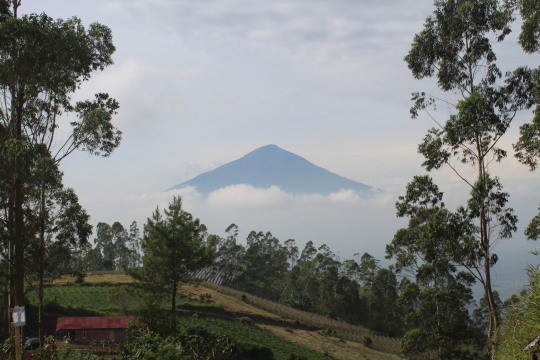
View On WordPress
#agrobisnis#agrokultur#arabica#arenga pinata#arenga sugar#areniss#areniss garut#areniss reseller#black coffee#business#cafe#coffee addict#consumers#culture#diabetic sugar#distributor#farmer#filosofi kopi#Garut#go green#gula aren#gula aren asli#kamojangparadise
0 notes
Text

#kim taeyeon#taeyeon#snsd taeyeon#snsd#girls generation#Mixed Media#paper art#papercraft#art#artists on tumblr#artwork#design#handmade#illustration#singapore#singapore culture#singapore breakfast#kopi and toast#kopi siew dai#cute art#creative#fanart
0 notes
Text
I recently posted this image of Kuchi Kopi
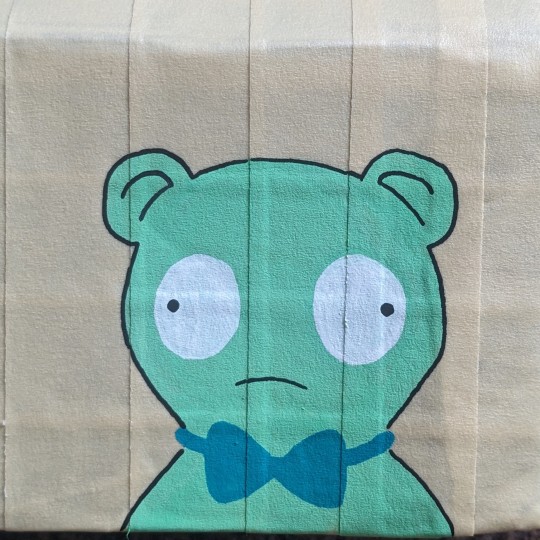
To which user @demiaries posted these tags

Which got me thinking..
Kuchi Kopi, canonically does not wear a bowtie (left image: S1E2 Crawl Space // Right image: S7E1 Flu-ouise)
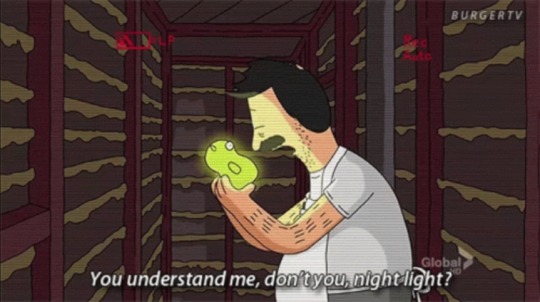
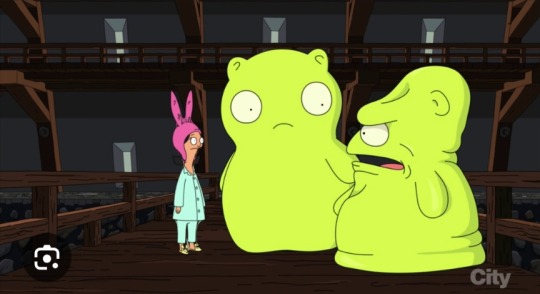
The only time Kuchi does in fact wear a bowtie, is in Bob's hallucination (again S1E2 Crawl Space).
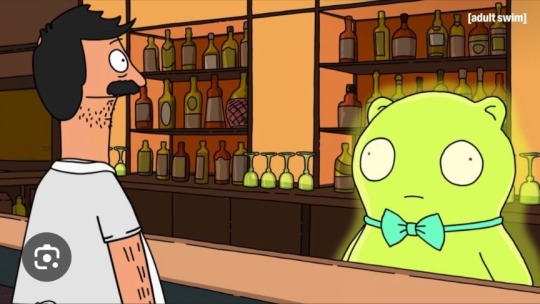
Now, some may believe this to be the production team still deciding on Kuchi's final character design. But, what if it's more than that?
In S11E2 Worms of In-Rear-Ment, we learn that Louise considers the bolo tie the pinnacle of sophistication, class, elegance, etc.
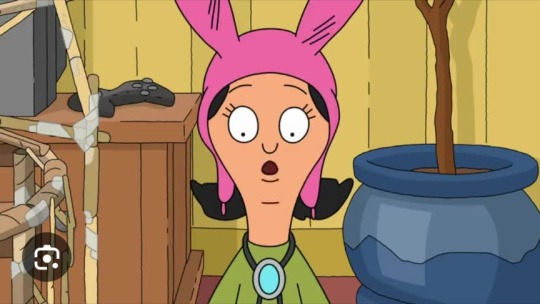
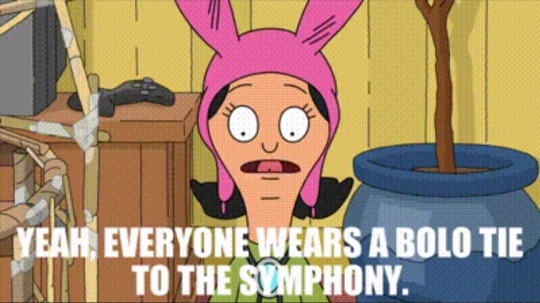

The use of "crack a book" (canon quote) here implies a "you should already know this" tone to the concept of bolo ties being elegant or classy. Louise thinks they're fancy and she expects you to, as well.
Louise has got this concept from somewhere, and we know Bob is her favourite parent.
So, what if, rather than the bowtie just being character design trialling, it's an intentional hint that Bob - and in turn, Louise - both consider neck accessories to be status symbols?
But why would Bob think Kuchi Kopi is fancy?
Seems to be a trend that older generations see things like international media to only be for "smart" or "cultured" people. (Unsure why, but that's a tangent anyway). As well as them seeing neck ties as "professional" in work culture and whatnot.
So, what if Bob is part of the demographic of people to discover anime/manga is from Japan and go "oh it's from Japan, so fancy"? Like Bob would definitely fangirl over Wagyu beef bc it's beef from Japan, y'know?? It fits for Linda's character and Bob/Linda are from the same generation, so it's plausible.
Long post short:
Bob thinks Kuchi Kopi is fancy and that's why we only see Kuchi in a bowtie in Bob's imagination.
#bobs burgers#bob's burgers#burger headcanons#bobs burgers headcanons#bob belcher#louise belcher#kuchi kopi
8 notes
·
View notes
Text
First Empress Glossary
Since The First Empress uses a lot of Classical Greek terms (or at least the English spelling of them), it seemed prudent to include a glossary of terminology on top of the footnotes that define them in the text. I like the Greek flavor that the terms add to the setting and world-building, but I don't know if I'll decide (or even be allowed) to keep all of these terms in the final published draft. Regardless, here's the current glossary that will be included in an appendix at the end of Book I (listed under the cut for length reasons):
Apeleutheros/apeleutheroi: singular and plural for freedmen, former slaves.
Archon: title for an aristos who holds a government office, such as a magistrate or councilman. Duties and organization varied considerably from polis to polis.
Aristos/aristoi: singular and plural for aristocrat. Common title for Tollesian nobles, may also be used as an honorific, similarly to my lord or my lady.
Aspis/aspides: singular and plural terms for a concave Tollesian round-shield, popular with hoplites and other infantry across the Vestic Sea. Typically around three feet in diameter, aspides may be made from solid bronze but are more often thin bronze with a wooden backing or leather over a wooden backing. Aspides strap to the forearm and are frequently painted with designs or devices on the front.
Barbaros/barbaroi: singular and plural often derogative term for any person who’s native language isn’t Tollesian.
Bireme: originally developed by the Venarri, biremes are mid-sized warships with two tiers of around thirty rowers on each side. Typically around 80 feet long. Though somewhat obsolete compared to modern hemiolia and trihemiolia warships, biremes remain popular as support ships in navies across the Vestic, Tornis, and Istartus Seas. Slangily called twos by sailors or deuces by dice-players.
Chiton: popular unisex garment among Tollesian cultures. Similar to a robe or a dress and consisting of one to three sheets of linen or silk held together by belts and pins. Comes in many styles, cuts, and colors.
Democracy: a relatively new and fairly unpopular form of government where landowning citizens elect public leaders and vote on major issues.
Doulos/douloi: singular and plural for chattel slaves. Typically indentured for life, they made up by far the largest percentage of classical-era slaves, typically employed in grain-fields, lumber camps, mines, kilns, barges, brothels, and other places that involved back-breaking manual labor.
Eleutheros/eleutheroi: commoners, freemen.
Êrus/êras: male and female form of address from slave to master or mistress.
Exomis: a type of tunic pinned at one shoulder, rather than sleeved.
Geomoros/geomoroi: singular and plural for small-time landowners, typically farmers, who frequently made up the largest percentage of Tollesian soldiers.
Hetaira/hetairai: singular and plural for high-end courtesans who provided sex, music, dancing, and other entertainments for their clients.
Hegemony: a coalition of Tollesian and/or Venarri poleis, usually led by the polis with the strongest army.
Hemiolia: light, fast war-galley with one-and-a-half tiers of oars to the bireme’s two. Sleeker and swifter but less durable than the bireme. Slangily called hems or one-and-a-halves, hemiolia are popular as privateers, patrol craft, and scout vessels.
Hoplite: heavy spear-infantry soldier that makes up the bulk of Tollesian armies across the Vestic Sea. Depending on context, the term may also refer to any Tollesian infantry soldier or to Tollesian soldiers in general.
Hypocras: a heated, spiced wine, popular as a breakfast beverage.
Kopis: Tollesian name for a single-edged slashing sword with a forward curve and bulging taper toward the end. Popular sidearm among infantry and cavalry in many cultures and kingdoms.
Lembus: originally designed by the seafaring tribes and kingdoms that would later become the Illaran League, these are light, swift galleys with a single tier of oars. Popular among Tollesian and Venarri commerce- and coastal-raiders, they also see use as patrol-, scout-, and skirmish-craft in many navies.
Linothorax/linen cuirass: a hardened linen or linen-and-leather composite armor popular among Tollesian and Venarri soldiers but also not uncommon in armies from other cultures. May include thin, stamped bronze scales adhered to the spaulders, midriff, or chest.
Lochagos/lochagoi: singular and plural for an officer who leads individual detachments (lochoi) of soldiers or carries out the strategos’ orders in the land army. In the navy, lochagoi are shipboard officers who command an individual warship’s marines—separate from the ship’s captain who commands the sailors and rowers (see: trierarchos). Seniority may be based on merit or length of service.
Lochagos hippeis: Master of Horses. Senior officer in charge of the army’s cavalry.
Lochagos hoplitai: Master of Hoplites. Senior officer in charge of the army’s heavy infantry.
Lochagos psoloi: Master of Skirmishers. Senior officer who coordinates the army’s ranged infantry, including javelins, archers, and slingers.
Lochos/lochoi: singular and plural for a band of soldiers who are either a part of a larger army or who have been detached from the main army, whether as a patrol, garrison, or other mission.
Metoikos/metoikoi: singular and plural for foreign resident living in a Tollesian polis. Could refer to non-Tollesians or Tollesians originally from another polis.
Oiketes/oiketoi: household slaves or indentured servants. Typically these included cleaners, scullery maids, cooks, tutors, bed-warmers, stable hands, groomers, seamstresses, barbers, or anyone else employed by aristoi or geomoroi for help around their households or businesses.
Oligarchy: system of government where rule rests with a small number of people (oligarchs). Oligarchs may be military, familial, political, elected, religious, or even mercantile leaders, particularly in Venarri poleis in the latter case.
Pankration: a mixed martial art popular in many poleis, combining punches, kicks, holds, and chokes found in boxing and wrestling.
Pelta/peltai: singular and plural for a small or medium crescent-shaped shield, popular with Tollesian javelin-skirmishers (peltasts).
Peltast: Tollesian name for ranged, light-infantry soldiers with shields and javelins. Specifically refers to javelin-throwers with linothorax armor and pelta or thureos shields, but depending on context may refer to any javelin-soldier.
Penteconter: an older class of warship with a ram on the prow and a single tier of 25 rowers on each side. Largely obsolete, but still popular among pirates and smaller poleis. An archaic design that led to the development of later biremes and triremes.
Phalanx: formation of hoplites or similar spear-units, arranged in a solid line with spears and shields facing forward.
Polemarchos/polemarchoi: singular and plural for a Tollesian warlord. May refer to a warrior-monarch or to a polis’s highest military commander.
Polis/poleis: singular and plural for “city-and-state.” Rather than kingdoms, many Venarri and almost all Tollesian nations are organized around city-states and their neighboring townships. Regardless of individual government type, the polis forms the nucleus of Tollesian cultural and political identity.
Quadrireme: a new, heavy class of warship, featuring two tiers of oars with two rowers per oar. Found exclusively in the navies of the Empire of Pellastor, their use in combat is still under experimentation. Though most poleis are aware of their existence, their exact construction is a closely guarded secret. Slangily called fours.
Quinquereme: a new class of heavy warship, recently designed by the Empire of Pellastor. Features three tiers of oars, the top two tiers requiring two rowers per oar. Larger than a trireme in all respects, their construction is a closely regarded secret, but their performance so far suggests they may replace triremes as mainstay ships-of-the-line for most major poleis. Slangily called fives.
Rhyton: horn-shaped drinking vessel, often sculpted with fish, bulls, or other animal motifs. Typically made from glass, tin, or brass.
Strategos/strategoi: singular and plural for highest ranking officer in charge of an army or fleet. Size of army or fleet and number of strategoi per army depends on individual polis’s organization. Seniority is often based on length of service.
Tetrarchy: system of government where a polis is ruled by four individuals (tetrarchs), commonly either elected leaders, military leaders, or heads of the four most powerful families.
Thureos: Tollesian name for a tall, oblong shield, generally around three feet wide and over four feet tall. Gripped behind a bronze boss instead of strapped to the arm, they’re typically made from leather stretched over a wooden backing, often painted. Originally adapted from Gannic warriors, thureos are becoming popular among heavy peltasts and slingers as well as non-traditional hoplites.
Trierarchos/trierarchoi: singular and plural for the captain of a warship. Often appointed by either the warship’s owner or by the military.
Trihemiolia: a swift medium warship featuring two and a half tiers of oars to the trireme’s three. Faster but less durable than the trireme, trihemiolia see use as support ships in battle, but are better deployed as commerce-raiders, pirate-chasers, or patrol craft. Slangily called two-and-a-halves.
Trireme: mainstay man-of-war on the Vestic, Istartus, and Tornis Seas, originally invented by Venarri shipwrights. Usually around 100-120 feet long, triremes are propelled by sails and by three tiers of 25-30 rowers on each side. Slangily called threes by sailors and marines.
Tyrant: an illegitimate ruler—frequently either a conqueror or usurper, though the term may also be used as an insult toward unpopular leaders who are legitimate.
Xenos/xenoi: singular and plural for stranger or outsider. May just as easily refer to a non-Tollesian or to a Tollesian from another polis.
Xiphos: a short stabbing sword with a leaf-shaped taper. Popular sidearm with Tollesian infantry.
15 notes
·
View notes
Note
You’ve probably gone over this before but tumblr’s search engine sucks butt. So, what would each culture’s staple crops and livestock (for both meat and byproducts) be? How much would globalization come into play, like how irl potatoes are originally from South America but have become one of the most important staple foods across the world?
Staple crops and livestock vary throughout the Provinces due to climate and geography, though trade over the centuries has meant that ingredients like saltrice from Morrowind and honey from Skyrim are in constant circulation around the continent. Nonetheless, here are some uniquely local ingredients you'll find across Tamriel.
Altmer
Summerset's temperate climate makes it the ideal place to grow all sorts of exotic fruit, especially stone fruit. From peaches to lychees, nectarines to cherries, Summerset produces the largest quantities of these fruits (with the trade embargo around the Great War and Dragon Crisis making them an extremely sought-after prize). And don't forget the wine! Summerset is also famed for its gorgeous vineyards and even more gorgeous wines. However, juicy and flavourful grapes are beloved by almost anybody, making them a valuable staple crop too.
Livestock in Summerset is nothing particularly exciting. Merino sheep are farmed for their wool, which is a luxury export beloved by northern Provinces, while meat comes in the form of cattle and chickens. However, High Elves particularly love their wild-caught fish and herons, which are populous on their home island.
Argonians
Once again, fruit is a major export from Black Marsh, but the fertile (if hostile) region is home to some of Tamriel's best agricultural soil. From cocoa and coffee beans, saltrice and coconuts, to padan and banana leaves and more, you'll find all sorts of wonderful plant-based ingredients in Black Marsh. However, something that has gained in popularity following the Argonian diaspora has been palm wine, a potent alcoholic beverage.
As for livestock, you'll find bantam guar, guar lizards, various poultry, goats, and even farmed frogs and lizards to be popular. Sheep and cattle are far less popular due to the upkeep required for them to stay healthy in the swampy environment, making beef and mutton less popular and more expensive than in other Provinces.
Bosmer
The Bosmer are famed for their meat and animal byproducts, particularly from timber mammoths and sugar mammoths. Whether it's meat, pelts, or milk, these beasts are much beloved by the Wood Elves who take great care in rearing them.
Other popular exports from Valenwood include alcoholic beverages like rotmeth and jagga, as well as kopi luwak- a luxurious type of coffee made from beans found in civet cat excrement, thus making them Green Pact-friendly. And of course, Valenwood produces some of Tamriel's finest cocoa beans, mostly used for export. However, have you truly lived until you've tried salted sugar mammoth caramelised milk chocolate from Woodhearth?
Bretons
In High Rock, sheep and cattle are the most popular livestock to farm due to their versatility, with a constant demand for their meat, horns, skins, and milk. While it's nothing exciting, the animals in the region are usually grass-fed and free range, spanning acres of farmland (which can sometimes result in cultists and the like infringing upon the livelihood of livestock). Chickens, geese, turkeys, and ducks are also popular for their meat, down, and eggs, with High Rock producing some of Tamriel's best duck meat.
With regards to staple crops, wheat is a major export and features heavily in Breton cuisine, especially in bread.
Dunmer
The volcanic ash of Morrowind is key to its success in growing all manner of weird and wonderful crops. Market stalls across Vvardenfell and Blacklight bustle with sellers touting mushrooms of all kinds, saltrice, comberry, marshmerrow, hackle-lo, canis root, and much more, all of which are consumed locally as well as across Tamriel.
Regarding livestock, it should come as no surprise that the big money is in bug farming. Kwama mines produce cuttle, scuttle, scrib jelly, and kwama eggs, making them the backbone of Morrowind's mages and chefs alike. Nix-hounds and guar are raised both by town Dunmer and Ashlanders, while wild nix-ox is also popular for those who can afford it.
Imperials
Cyrodiil spans terrain from the snowy Jerall Mountains to the swamps of Blackwood. As a result, the Province is relatively self-sufficient in that it produces the bulk of its own consumption, from livestock to greens. Speaking of greens, battaglir, a type of weed, is a staple in the Imperial diet, making wild-foraged and farmed battaglir a key crop in the region. Like Summerset, Cyrodiil is also famed for itswines, and is proud of its unique grapes of every size, flavour, and colour (including ones that taste like cotton candy).
Livestock in Cyrodiil is about as generic as can be: cows, sheep, goats, poultry, and horses. While meat is a staple part of the Imperial diet, milk is also important as it is used to make the cream and cheeses so prized by the Province.
Khajiit
What don't the Khajiit grow or rear? From Southern Elsweyr's rich moon sugar and rice paddies to the North's edible cacti and tea, the Province is full of exotic and scrumptious delights that are highly prized across Tamriel. Ingredients are valuable both raw and processed, and form the backbone of the Khajiiti economy. Samar Pekoe tea, for example, is wild-harvested from caves and is beloved by tea aficionados across the continent, and fetches a hefty price for its rarity. Pellitine cacao and coffee beans are also a staple in any self-respecting chef's kitchen.
In terms of livestock, you'll find guar, poultry, beef, and goat to be popular, as well as wild game like jerboas, terror birds, antelope, and addaxes. Game meat can often be purchased from Bandaari nomads, who hunt the animals themselves. Whether fresh or dried into jerky, who doesn't want some moon sugar-cured addax jerky for the road?
Nords
Foreigners in Skyrim are often shocked by the range of produce we're capable of producing in our cold and often inhospitable lands. Fish and horker are consumed in great amounts locally, as well as being one of the Province's major exports. Goat from the Reach, cattle from Whiterun, and honey from the Rift are always in high demand.
Apples and jazbay grapes are probably the most valuable crops in Skyrim, followed by wheat and other fruits and vegetables. The former two are used in cider and wine, both of which are valued across the Provinces.
Orcs
Wrothgarian Orcs differ from Betnikh Orcs who differ from Wood Orcs and so on... so in this case, it really varies. For Wrothgarian Orsimer, echatere is the main source of meat and milk, while in Betnikh it's fish, and in Valenwood, timber mammoth. All these groups also enjoy game, from rabbit and wolf to pheasant and venison, which features heavily in regional Orcish cuisine. Wild honey from Betnikh is also another notable animal product that bears mention here.
In terms of crops, there aren't many of note aside from valuable herbs and spices. Frost mirriam, which is also loved by alchemists, and wrathberries, known for their violently bitter taste unless prepared correctly, are two of the most important plants you'll find for sale at any stronghold.
Redguards
I've said it before and I'll say it again: goat, goat, and more goat. Unless you're a coastal Redguard with access to seafood, it's likely that your main source of meat and milk will come from goats. Whether it's feta or kebabs, it's almost always goat meat, as they wander all through Hammerfell like they own the place. However, Redguards are also renowned for breeding horses, and the uh... faulty ones are generally turned into food. Spiced horse blood sausage and spreadable horse 'nduja are a staple in households across Hammerfell.
With staple crops, you'll find that corn, coconuts, palm fruit and oil, bananas, coffee, cinnamon and other spices, and cocoa are plentiful. These are all consumed in great amounts within the Province, but are also highly prized across Tamriel.
51 notes
·
View notes
Text
LoZ: Wild - BotW VS TotK Weaponry
I'm honestly a bit upset that they took out the Silverscale Spear (technically, it should've been called a bidant), Moonlight Scimitar, Serpentine Spear, Vicious Sickle, Demon Carver, & such. The Moonlight Scimitar & Silverscale Tridant were especially pretty.
Interestingly, Demon Carvers are a weapon pretty unique to BotW that might be inspired somewhat by feng huo lun or wind-and-fire wheels. Unlike Chakram, which are made to be thrown, feng huo lun are used in melee. However, feng huo lun do not possess handles the way that Demon Carvers do. Rather having a bar inside the rings that you're supposed to grip. However, realistically speaking, this weapon wouldn't really be very effective as niether were feng huo lun. It think that they'd be called Oni-hori Enkama (Demon-Carving Circular-Sickle, 鬼彫り円鎌). - As opposed to the canonical name of Oni Enba (鬼円刃, Ogre Circular-Blade) as not only does it seem more like a sickle weapon, but I just wanted to keep the kanji for "demon-carving" in there.
I also kinda wish that they traded the Golden Claymore for something like a Dadao (maybe with some inspiration from the Greek Kopis). Just something that would more resemble a large, 2-handed scimitar.
Maybe add things like Kodachi, Naginata, Kunai, & Zanbatō to the list of Sheikah/Yiga weapon sets, then maybe name the Eightfold Blade an Ansatsu Wakizashi (1-handed assassination sword) or Sheikatō (after the Ninjatō) & the Eightfold Longsword a Sorikaze Katana (2-handed windcutter sword). Also, they should've kept some of the aesthetic from the Windcleaver with the Eightfold Longsword. I loved the look of that sort of wavy groove in the middle that lit up & the holes. Like halves of 2 different blades fused together!
I mean... I suppose that the Gloom Spear is technically a Naginata now that I think about it, but still.
It'd also be really neat to have an Urumi or Razorchain Sword type of weapon too. Maybe add in some hand & a half swords.
Also cool to add would be a Dadao or whatever type of massive, two-handed sword it was that Koloktos used. Or a sword inspired by the Sword of Manjushri, a.k.a. an old Khagda Wisdom Sword.
Khopesh for the Gerudo would also be cool!
Another cool thing would've been cutlasses. Like, seriously, one of Hyrule's ancient princesses was an effing PIRATE QUEEN!! Why are there no cutlasses??
I mean, sure, you could probably call the Moonlight Scimitar a cutlass if you wanted to, but it's just not the same... ;_;
Also, the various types of Lai'o'manō for Lurelin weaponry! Like the most commonly known Lei'o'manō, a Palau Papanihomanō (sharktooth club) or a Pahoa'i'a'me Lei'o'manō (sharktooth spear) or Ku`eku`e Lima Lei'o'manō (sharktooth knuckles). And maybe some other stuff like an Ulimasao (paddle club used to end war & steer towards peace) or Nifo'oti (cane knife) or an Aufana (bow)!
It would've also been cool for the Zonai to have something like a Macuahuitl. Or wooden war club with obsidian razors down the sides.
---
Can we also talk about how interesting it is that the Gerudo are inspired by Egyptian/Middle Eastern cultures, yet their weapons are very powerful, but not durable? Because, this very much contrasts with how actual Middle Eastern weaponry were historically.
It suggests that the Gerudo don't really have access to very high-quality iron in the desert, so the advantage of their weapons comes in their design & forging method which, due to the curve of the blade, results in more cutting power. (Which itself is actually accurate to the Middle Eastern sword design of pattern welding.)
Contrast that with the Middle East having ready access to things like Damascus Steel, which is made from extremely high-quality iron, while also having wonderfully designed blades, thus making them both deadly & durable.
Which, when I look, the Yiga's weapons are more durable than the Gerudo's. This suggests that their weapons might be made of better stuff despite their main base being in the Gerudo Highlands & thus right next to the desert.
This implies that my theory that the Desert doesn't have very good forging material (instead having an abundance of high-quality jeweler's metals), but the Highlands do, might be correct.
Which would make the metal that the Yiga are working with, most likely, the Hyrule equivalent of Damascus steel.
However, at the same time, the Yiga's weapons aren't much more durable than the Gerudo's weapons. Which could mean that the Yiga aren't really very good blacksmiths & if the Gerudo got their hands on this steel, then it could increase the durability of their weapons by leaps & bounds.
LoZ Wild Masterlist
LoZ Cultural Masterlist
9 notes
·
View notes
Text
I saw @cerastes posting about his mom and about how she like causing Chaos and Puzzlement, which reminded me of an incident.
My old workplace was in a mall next to a hotel, and we’d get a lot of tourists as a result, and they’d tend to get up early, and the mall has a coffeeshop of sorts which is open and tourists tend to go to it because it’s a local coffeeshop chain (Fun Toast for the locals reading this). For breakfast that’s really all the mall has, it’s that or Subway and Macs, and the tourists tend to go for the coffeeshop because it’s something they don’t have in their countries.
Now, one morning, I went there to pick up a cup of tea, as I always do. And I notice this American family standing to one side, peering at the menu. And I hear them talking amongst themselves, trying to puzzle out the different things on the menu. Because it doesn’t say “tea” or “coffee” it says “teh/kopi/teh-c/kopi-c” that sort of thing. And they have no idea what it means. And everyone is ordering in Chinese - they have no idea what the customers are saying either.
See, down here in Singapore ( and a lot of SEA countries) there’s a certain lingo for ordering tea aka teh or coffee aka kopi. You order a kopi-siew dai if you want a coffee with less sugar, a kopi-c if you want a coffee with evaporated milk, a kopi-ping if you want it iced, a kopi-kosong if you want it without sugar, a kopi-o if you want it black. And you can combine all these options so you could, for example, order a kopi-c-siew dai-ping for an ice coffee that’s less sweet and made with evaporated milk.
And all of these options are listed on the menu. And this tourist family is lost beyond all reason. However, like a ray of light from the heavens, who should turn up but Mike.
Mike is also an American. Mike comes by, gives me a wave of greeting, and then he notices the American family. He realizes, they’re relying on him to somehow decode the menu for them in a fashion they can understand - in fact they queue up behind him so they can (i think) learn what this guy was ordering and order the same and be (relatively) safe.
Unfortunately for them, Mike had been living in Singapore by that point for about a decade, and was fully immersed in the local culture and the coffee lingo. More to the point, he came to this coffeeshop very often and the staff there knew him. And, as I was to learn, he apparently was capable of being a massive troll.
Fully aware of the hopes this family of tourists was pinning on him, Mike steps up to the counter. He opens his mouth to order. The family leans in with bated breath, hoping to listen in, that they can start to comprehend, perhaps, by proxy, what the menu means.
What does Mike do? Mike orders, in quick succession and with perfect pronunciation, a kopi-c-siew dai-gao, kopi-o-kosong-gao, teh-o-kosong-ping, teh-c-siew dai-ping, ying yang-siew dai-ping.
The tourist family’s faces change. From one of hope to one of utter despair. Worse than not comprehending, he’d ordered something that wasn’t even on the menu! But the staff knew Mike well enough that they made it for him anyway!
As Mike turned away from the counter, with his drinks in hand, I saw the biggest shit-eating grin on his face. I could only sit in awe and wonder at this man, who’d intentionally placed as confusing sounding an order as he could come up with, for the sole fact of messing with this random family of tourists that he didn’t even know.
What about the tourists, you may ask? Well, simple.
They (sorta) gave up, and just went with normal tea and coffee for their drinks.
#i still stand in awe of mike's actions that day#he actually also gave me one of the drinks because he'd noticed that's what i ordered every morning#i think the tourist family also came to like the local tea and coffe#cause i saw them most mornings for the next two weeks#singapore stories#also i make it sounds like teh and tea are different but they aren't#teh is just tea with milk and condensed milk#admittedly tastes fairly different from like english breakfast teas but still
3 notes
·
View notes
Text
Kesabaran yang setipis tisu toilet
Setelah jadi ibu-ibu tukang kopi seduh dan mie rebus, loba culture shock anu salila ieu can pernah dialaman selama uing jadi tukang warung sembako. Ternyata jadi pedagang sembako dan warkop teh bedaaaa yagesya. Ari jadi tukang sembako mah emosi teh aman indah lahir batin, nu mareuli sharoleh. Dina rudetna ge paling panggih jeung jalma anu nawar roko hayang lima rebu tilu. Jaba rokona hayang mild embung dibere roko samsu (wkwkwk jadi apal kana roko) ari jadi tukang kopi mah pangrasa teh kabeh jalma rese, loba kahayang, teu sabaran. Komo kawasan pasar mah lolobana syaitonirojim. Kesabaranana setipis tisu teh nyaan alias sumbu pendek. Teu kaopan enya ge cangkangna manusa kolot geus huisan ge adatna bubudakeun. Teu payaan. Mun ceuk si bapa mah hulu huisan ge kolotok munding senah.
Nyeduh kopi caina loba saeutik sewot. Cai na dibahekeun hareupeun pisan uing nu nyieunna. Marah? Oh tentu tidak. Masang senyum aja sambil minta maaf dengan nawarin "mau diseduhin ulang?" Ti dinya asa rujad si opon teh. Hayang langsung ngagarawak mun teu inget kalimat istighfar mah. Jadi hayangna teh cai na satengah gelas gaesss. Atuh teu ngomong nya. Naon hesena reques cai na satengah wae ulah loba teuing kituh! Pan beres .
Menta roko, ditanya roko naon ngajawabna teh piraku teu apal apal. Heh maneh tulak panto! Samaruk nu balanja ka aing nyaneh hungkul! Piraku nu meuli hiji hiji na kudu apal selera jeung kahayangna. Da lain mamah Lauren urang teh. Jaba urang teh jalma anyar teu apal langgan henteu na, hayangna kumaha kumahana. Sakieu ge geus alhamdulillah. Nedunan kahayang nu meuli itu ieu kahayangna rupa rupa jaba ngangais budak. Cik atuh mikil! Kahayangna kudu prioritas ari taeun kasbon wae dasar jalma teu begu.
Maap gaess kesel atuda. Jadi intina mah sifat urang teh bisa kapangaruhan tina lingkungan. Ayeuna cicing dina hiji lingkungan anu panas, urang ge berangsur-angsur kabawakeun panas, atau sabalikna. Jaba jadi tukang warung mah kudu loba sabar, da mun teu kitu atuh moal aya nu meuli. Meureun moal mengalir tah si cuan teh. Ingat kita perintis bukan pewaris. Anjaaay.
Yasudah gaes rek nyeduh kopi heula ah, cag...
3 notes
·
View notes
Text
Unit 9
My time in Bali, Indonesia opened my eyes to a world of nature that I had no idea existed. I felt immediately connected to nature and the way that the locals use their land. The respect that the people of Bali have for the animals and the nature they live with is inspiring. This trip taught me so much about how the people and the animals interact in so many new ways.
One of the most interesting and shocking things I discovered on this trip was Kopi Luwak. This is a coffee made from partly digested coffee cherries. An animal called the Asian Palm Civet eats the coffee cherries and as they pass through the intestines, they are fermented and then defecated. My family and I visited a Kopi Luwak shop and were given a tour of the sanctuary where the Civet cats are kept. They explained to us the process of obtaining the coffee but also the cultural significance of the drink to the people of Bali. They explained how many of the Kopi Luwak coffee shops keep their Civet cats in terrible conditions where they are forced into cages, but this specific family was operating a sanctuary where the Civet cats are treated humanely. Learning about humane animal practices in popular tourist destinations was also an eye opening experience for me.
Producing coffee in this way was discovered by the local people during times of colonization by the Dutch, as local farmers were not permitted to harvest their coffee beans (Muzaifa et al., 2019). To work around this, the farmers realized that as a part of the Civet’s diet, they consume coffee cherries and do not digest them (Muzaifa et al., 2019). They were able to collect them from the feces and clean them properly (Muzaifa et al., 2019). The beans are collected from the feces of the Civet, washed, dried, and the skin on the outer portion of the bean is removed. At this point, the beans are either stored away or roasted (Pierce-Feldmyer, n.d.). I remember drinking the coffee and wondering why it almost had a slight lemon scent, and the farmers explained it was a byproduct of the fermentation and these beans have a higher level of citric acid than regular beans.
This type of coffee is some of the most expensive in the world, with 100g averaging $80 in the United States (Pierce-Feldmyer, n.d.). The reason for this is due to the amount of work that goes into producing this coffee (Pierce-Feldmyer, n.d.). This includes caring for the Civets, collecting their fecal matter, and doing the intensive cleaning process. The demand for this coffee led to discovery of more efficient harvesting methods, which is where the mistreatment of the animals came into play (Pierce-Feldmyer, n.d.). This allowed me to realize how delicate the line between mass consumption and cultural significance is when it comes to nature. What once was an important cultural staple that represented balinese history has become a worldwide delicacy and the Indonesian relationship with the land has changed. This is an example of bring nature interpretation into my everyday life (Beck et al., 2018).
Beck, L., Cable, T. T., & Knudson, D. M. (2018). Interpreting cultural and natural heritage : for a better world. Sagamore Venture.
Muzaifa, M., Hasni, D., & Rahmi, F. (2019, October). What is kopi luwak? A literature review on production, quality and problems. In IOP Conference Series: Earth and Environmental Science (Vol. 365, No. 1, p. 012041). IOP Publishing.
Pierce-feldmyer, A. What is Kopi Luwak and why is it so expensive?. https://sciencemeetsfood.org/kopi-luwak/
2 notes
·
View notes
Text
Assignment 3: Information Design
Upon receiving the assignment prompt, I knew that I wanted to do something related to drinks in Singapore. Initially, I wanted to center my infographic around Chinese Herbal Tea, as I felt that it was something that was slowly being forgotten by the newer generations of Singaporean-Chinese.
SKETCHING
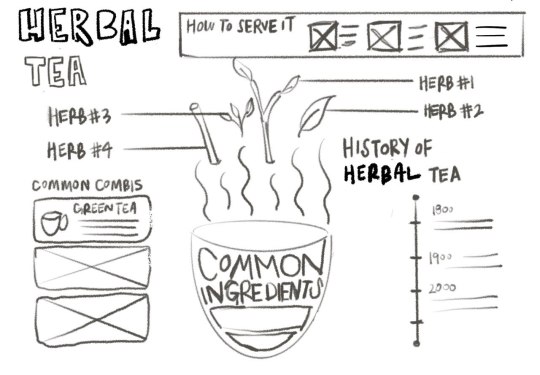
The sketch above is my very first draft of the infographic. I wanted to showcase some of the common herbs used in herbal tea, as well as popular herbal teas.
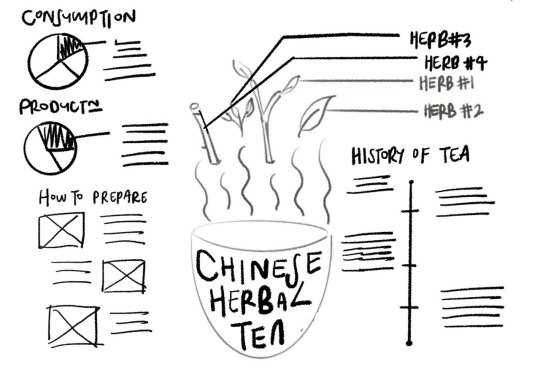
Second draft of my Chinese Herbal Tea idea (above)
However, I ultimately decided to change my main topic as I wanted to do something more unique to Singapore. I switched it to a different kind of drink, Kopi (the local term for coffee). With the influx of independent Western coffee shops nowadays, the Kopi culture in Singapore risks being forgotten after several decades.

Featured above is my final draft for the Kopi Culture infographic. Several elements were brought forward from the herbal tea drafts, such as the cup with distorted words, the timeline and ‘How to prepare’ sections.
I tried to play around with the arrangement of the components, and see if there was any way for me to fit in statistics without ruining the aesthetic and overall flow. When compared with the final product, it can be seen that quite a few elements shown here were not included, such as the line graph at the corner. Due to the many iterations between the initial sketch and the final product, the elements were changed a lot in the process.
WIREFRAMES
With a rough idea of what components I wanted and how they would look, I went forward with creating a prototype in Adobe Illustrator. Again, I spent quite a long time deciding the placement of the components. This was primarily because the sizing of the actual component turned out to be slightly different from the draft I made, and thus a lot of rearrangement was needed to fit the sections in nicely. At this point of wireframing, I was not concerned with the typography or colours of the components, but instead focussed more on their layout.
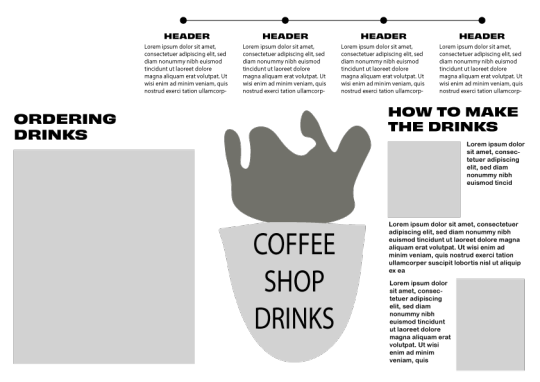

CREATING ASSETS
After deciding on the layout, I moved on to create the graphics that I would be inserting. After getting the shape of the elements, I also applied a few effects on the various objects to give them a more realistic and three dimensional effect.
Firstly, an envelope distort was used to add text on curved or angled surfaces, such as the side of the cups and blocks. This made the objects look more lifelike and less two dimensional.
Distorted text on the coffee cup:
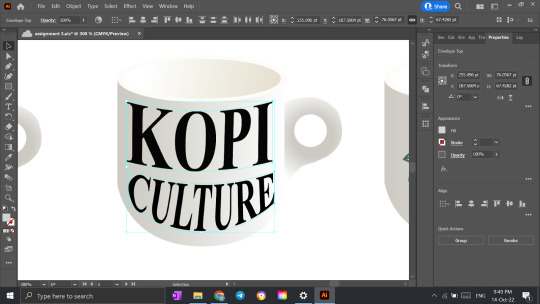
Distorted text on the milk carton and butter stick:

Secondly, a gradient effect was used on some of the curved surfaces to make it look more realistic.
As seen below, the metallic look of the holding can was achieved by applying a black-white gradient. A similar effect was applied on the coffee cup so that it would not look too flat.
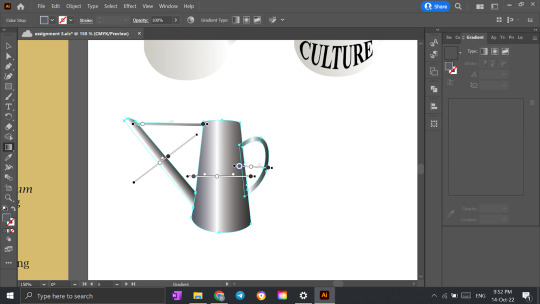
As seen above, the metallic look of the holding can was achieved by applying a black-white gradient. A similar effect was applied on the coffee cup (below) so that it would not look too flat.
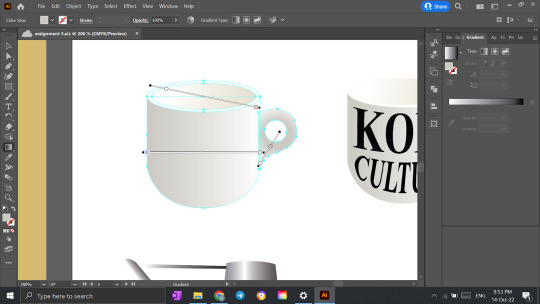
FIRST PROTOTYPE
After designing all the assets and doing the relevant research, I then pieced together my final prototype for critique, as shown below
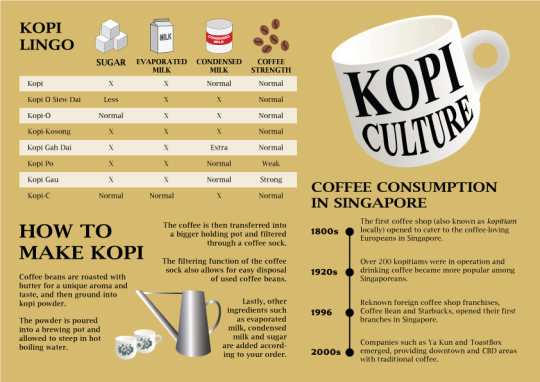
Colour Scheme & Typography
For the colour scheme, I decided to go with a light yellowish brown. This complemented the warm colours of coffee, but was also light enough such that all the component scan be seen clearly against it.
Since the infographic was about coffee, I tried to imagine the kind of setting one would drink it in, and the first thing I could think of was neighbourhood uncles sitting at the coffeeshop in the morning, with their cup of kopi and the morning newspaper. Thus, i decided to use a font that resembled that on a newspaper. I chose a serif font, Lucinda Bright, for the typography.
To implement visual hierarchy, I made the headers of each section demibold, as compared to the body paragraphs which were the regular typeface.
Title
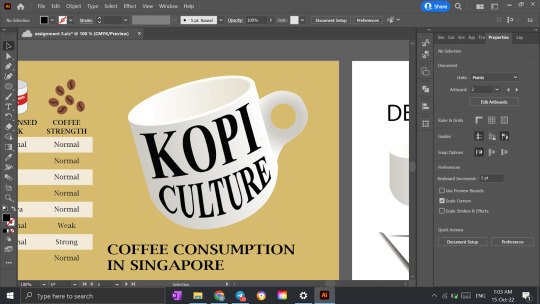
I wanted my title to not just be made up of plain text, but to also bring something to the table in terms of graphics. Thus, I decided to distort it to cover the side of a coffee cup, going along with the coffee theme of the infographic. I also made it visibly bigger than any other text on the page, so that it would be the first thing people's attention would be drawn to.
Kopi Lingo: Comparison Infographic

At the upper left corner, I created a comparison table of various Kopi lingo and what they mean. Ordering the different variations of coffee is something I struggle with (and I am sure many others do too), so I thought it would be useful to include. One of my initial ideas was to have a cup for each different drink, and draw the respective ingredients in the cups. However, I scrapped this idea quickly because I decided that it would be a tedious process for readers to have to look through each cup and remember which ingredients the drawings represent. Thus, I eventually went with the current format, which I feel provides a simple and easy way to compare the drinks and identify which one I would want.
How to Make Kopi: How To Infographic
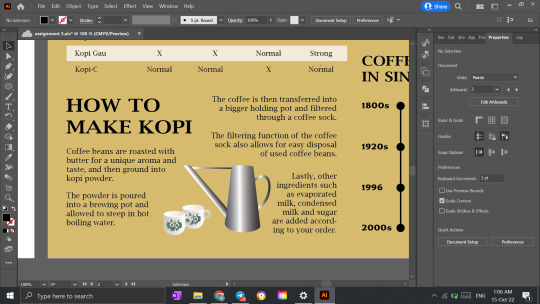
This section explains how Singaporean kopi is made. Admittedly, there is a glaring lack of visuals (will be covered later on), and is too reliant on the text to represent the information.
History of Coffee Consumption: Timeline Infographic

This timeline explores the development of coffee consumption in Singapore, from when the first ‘coffee shop’ was open. Similar to the above section, this timeline is too reliant on text as well.
CRITIQUE COMMENTS
Many suggestions and comments were made during the critique session, and are listed below (along with my respective changes)
Suggestion: Add more graphics to the ‘How To Make Kopi’ section and the timeline. In fact, the timeline can be removed so the How To section can expand and include more visuals.
The timeline was removed, allowing the 'How To Make Kopi' section to expand and take up the entire width of the infographic. Additionally, the text used in this section was reduced, leaving only the bare essentials that help to bring the point across. More drawings were also added, as they are essential in giving the reader a visualisation of how the coffee-making process looks like.
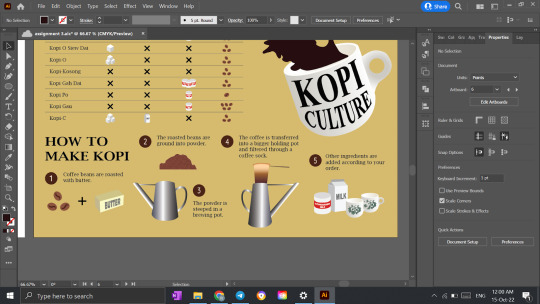
Suggestion: Represent the content in the comparison table using graphics instead of words. For example, more sugar can be represented with more sugar cubes, instead of the word ‘More’. Additionally, the X can be represented with an icon instead of text.
The words were replaced with icons as shown below. Additionally, the initially cream coloured alternate rows have been changed to thin black lines so the white icons stand out more against the darker background.
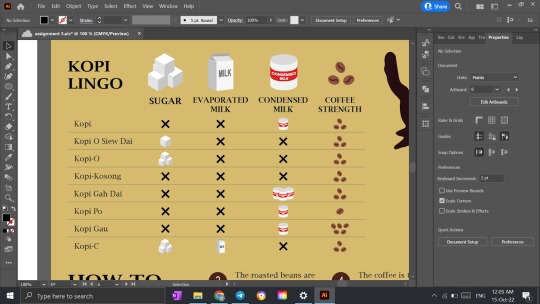
Suggestion: Remove the outline on the ingredient graphics so they appear more standardized across the infographic. If an outline is needed, use a thinner and lighter color.
The outlines were removed as shown below.
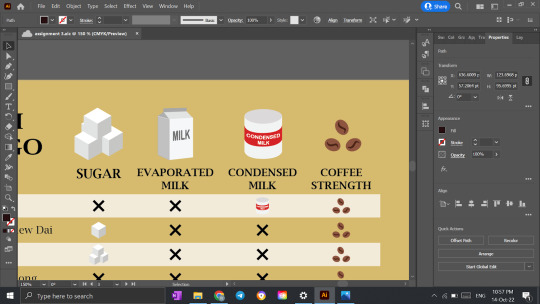
Suggestion: If possible, add a coffee spill to the cup.
A coffee spill was added as shown below.
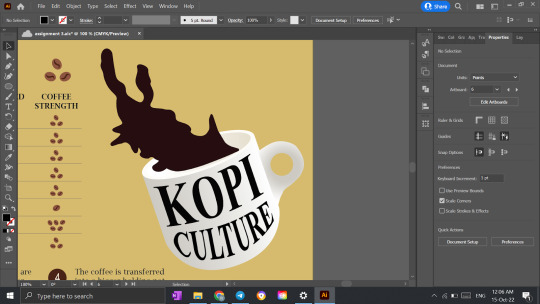
FINAL PRODUCT
After all the changes, here is my final product (along with the design assets and style guide)!
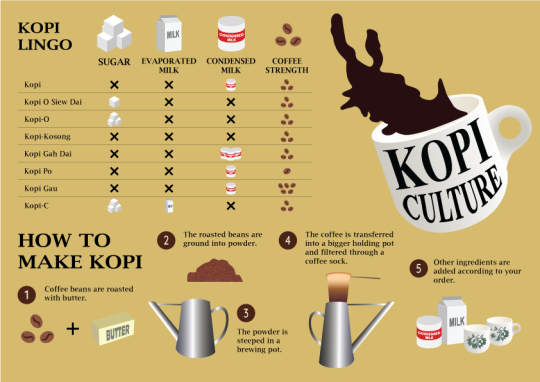

RESOURCES
Gyllensten, B. (2021). Understanding the Singaporean coffee market. Perfect Daily Grind. https://perfectdailygrind.com/2021/08/understanding-the-singaporean-coffee-market/#:~:text=The%20history%20of%20coffee%20in,to%20get%20through%20the%20day
Falkowitz, M. (2018). Snapshots from Singapore: A Guide to Singaporean Coffee. Serious Eats. https://www.seriouseats.com/snapshots-from-singapore-a-guide-to-singaporean-coffee-kop-how-to-order-how-its-made
Unknown. (2019). Order kopi like a local. Visit Singapore. https://www.visitsingapore.com/editorials/order-kopi-like-a-local/
Yeo, S. (2020). Singapore Kopi Culture. Fresh Cup Magazine. https://www.freshcup.com/singapore-kopi-culture/
2 notes
·
View notes
Text
Finally, WFO.
Seperti yang tertera di judul, hari ini, tepatnya 27 Mei 2022, gue WFO untuk pertama kalinya setelah genap 4 bulan gue kerja. Gue ngekost di Depok, kantor gue di Pancoran. Rute commute nya lumayan panjang. Dari kost, gue naek gojek ke stasiun Pocin. Selama di kereta, gue pikir gue bisa buka laptop, eh nyatanya mesti berdiri sampe di tujuan. Gue berhenti di stasiun Cawang, trus dari situ naek gojek lagi sampe ke kantor. DAN ITU GUE PERGINYA TENGAH HARI, BAYANGIN DEH SEPANAS APA. Di kantor pun, gue kebingungan walopun udah dikasih rutenya sama HR wkwkwk. Tapi akhirnya sampe, dan gue langsung tepar. Untung ada sofa dan bantal yang empuk, jadi napas sambil rebahan bentar. Abis itu, kerja deh.
Honestly speaking, sampe semalam sebelum hari H ngantor, gue deg-degan dan takut. Gue pikir gue udah ga cupu lagi dalam hal interaksi sama orang baru, tapi bayangan bakal ketemu langsung pertama kalinya sama orang yang udah kerja bareng sama gue selama 4 bulan tuh menakutkan di benak gue. Gue pikir gue akan sangat pendiam dan canggung, tapi mungkin thanks to kelelahan di jalan, pas masuk dan disambut Kak Meut, team leader gue, gue langsung yang, "Yaa Allah kak, tua di jalan aku." Dan kecanggungan yang gue kira akan terjadi pun musnah seketika detik itu juga. Gue bisa jadi diri sendiri aja gitu. Atmosfer selama kerja di kantor pun beda tipis sama pas kerja dari rumah masing-masing, alias masih seru dan lempar jokes sana-sini. Bahkan lebih seru sih, karena meetingnya di smart tv sambil makan siang bareng (Kak Meut traktir kopi sama roti sebelum itu huehehe mumpung gajian), trus pas di satu meeting room mesti jauh-jauhan gitu biar ga bergema banget. Seru lah pokoknya!
Trus, pas pulangnya, gue bareng salah satu senior sama satu intern. Intern ini beda arah keretanya, jadi gue satu kereta sama senior gue. Kita cuma selisih stop di satu stasiun gitu. Selama nunggu, kita ngeskip 2 kereta yang ALLAHU AKBAR PADAT BANGET. Badan yang biasanya rebahan ini pun culture shock wkwkwkwkwk Trus dari nunggu sampe memutuskan naik kereta (yang ga dempet-dempet banget isinya), kita ngobrol banyak. He asked me a lot of questions about my vision for the future, what do I want to do as a career. Setelah itu, dia cerita tentang dirinya sendiri, and honestly, it is eye-opening. He helped me discover a path that actually exist in the back of my head but I never dare to bring it onto the surface. Dia membuka opsi baru yang harus gue riset lebih jauh lagi. Senior gue ini tuh kalo kerja bisa agak nyebelin (tukang cari ribut, iseng), trus kalo serius soal kerjaan bisa jadi agak seram, tapi enak banget diajak diskusi soal hidup.
Gue turun duluan di Pocin, trus mesen Gojek. Awalnya masnya ga mau langsung jemput depan stasiun karena ada ojek pangkalan, tapi gegara gue liat ada gojek lain yang jemput, ya gue minta aja dia ke depan stasiun. Jujur, gue ga kuat lagi jalan, tas gue berat banget dan tangan gue juga udah merah gegara genggam pegangan di kereta tuh. Untungnya mau sih masnya heheh. Udah deh, sampe rumah, gue telfon Ibu sama Ayah yang ternyata sempet nelfon pas magrib. Trus, gue mandi, main HP, dan abis nulis ini mau istirahat.
Oh iya, hari ini juga kali pertama gue dapet gaji fulltime :""") Alhamdulillah, banyak banget berkah Jumat ini.
Gue pengen lagi sih ke kantor huehehe tapi ga tau juga sih, kalo ga janjian sama yang lain ya ga mungkin gue pergi sendiri.
Udah, segitu aja cerita hari ini ("aja" tapi panjang). Hope to have good days and create good memories for a month ahead!
3 notes
·
View notes
Text
What Insights Does Food Delivery Data Scraping Uncover About Indonesias Culinary Scene?
What Insights Does Food Delivery Data Scraping Uncover About Indonesia's Culinary Scene?
Indonesia has been the largest market in Southeast Asia for online food delivery businesses due to its large population and the adoption of the digital economy. Our distinct consumer panel captures up-to-date and comprehensive information on emerging markets through a targeted focus on food delivery data scraping in Indonesia. We have the most extensive proprietary data on e-receipts, which gives us the sole key to unlocking the future progress of the industry. The ability to track our dataset allows us to conduct deep analyses of macro-trends and detailed shifts in consumer behavior. It provides valuable information on what people eat, whether they order delivery, etc. More specifically, Indonesia's online delivery market history analysis shows a straight-line growth trend. Over the last two years, order values have shown encouraging growth of about 16.7 percent year-over-year. This data emphasizes the dynamic nature of the market and the occasions when businesses are there to cater to evolving consumer attitudes and market trends.
In the same way, online delivery companies in Indonesia have experienced a rise in the AOV (Average Order Value) following the incentives, from approximately 63.000 to above 68.000 IDR. It implies a favorable tendency in consumer expenditure within the food delivery segment. To obtain more comprehensive market dynamics and consumption patterns from 2019 to 2024, the most recent digital economy report provides an in-depth analysis and an impressive data bank. Furthermore, companies can draw on our food delivery data collection services to get helpful intel from their customers. Through this report and our food delivery data scraping service, we provide an insightful picture of the broadening market of online deliveries in Indonesia, and companies could take strategic advantage of the new opportunities by using this insight.
Unveiling Indonesia's Unique Food Delivery Landscape: A Dive into GrabFood Data
Indonesian cuisine is as rich and varied as its islands. Our analysis, powered by a food delivery data scraper, of GrabFood Indonesia sheds light on a fascinating trend: small restaurants dominate the online delivery space. In January 2024, about 75% of orders were from independent restaurants, with the remaining 25% from franchise brands like Mie Gacaoan and KFC.
Contrary to popular belief, in many markets, the top-selling foods on food delivery platforms are dominated by big franchises and fast food chains, which mainly leads to the quantities and cash value of the orders on the platforms. Meanwhile, the role is the total opposite in Indonesia. The local small-scale restaurants take center stage as they reflect the colorful fabric of Indonesian gastronomy and the deep-seated entrepreneurship genes of its culinary movers and shakers.
This specific feature reflects the necessity of being aware of cultural differences and sensitivities while trying to penetrate the Indonesian market. The importance of appreciating small merchants is noteworthy for businesses and investors pursuing opportunities in the growing food delivery market. By acquiring essential facts from a food delivery data scraping tool, the stakeholders can focus their strategies on Indonesia's dynamic culinary scene, which opens new doors for the expansion and maximization of the business.
Our detailed study on food delivery on GrabFood showed that the famous Mie Gacoan from the franchise restaurants is the most preferred option among customers. Well-liked brand restaurants like Richeese Factory, Kopi Kenangan, HokBen, and Solaria are among the other franchises. Interestingly, Mixue, a Chinese tea brand, also drew considerable attention, including its list as one of Grab's ten most-ordered franchise restaurants during the same period. Surprisingly, this outlet has a comparable order volume to the local coffee franchise Kopi Kenangan. This information uncovers a range of consumer choices with a high percentage of local and international cuisine on the GrabFood portfolio.
Top 10 Dishes Revealed Through Restaurant Data Scraping
Indonesia's gastronomic journey is explored in our compilation of the top 10 food-delivery website dishes. Beyond our obsession with data analysis, we are dedicated foodies. Through thorough analysis of our restaurant data collection endeavors, we show you what people love to order from Indonesian food delivery applications. What are the top 3 of this list? Drumroll, please! Based on our findings, the most highly selected ones are Chicken, Dish with rice, and Noodles (Ayam, Nasi dan dish, and Mie). Equipped with this understanding, your next meal in Indonesia you will undoubtedly enjoy! To sum up, we crave and feast on the variety of delicacies in this colorful gastronomic landscape. Our extensive data helps you pick the right place, be it classic Indonesian cuisine or international flavors.
Conclusion: The food delivery arena in Indonesia provides an opportunity to reflect the country's culinary heritage and consumer trends. The taste for Indonesian dishes has grown dramatically, from the dominance of small restaurants to the rise of franchise brands like MieGacoan and local heroes such as Richeese Factory and Kopi Kenangan; the scene brings together old and new flavors. However, Mixue, a Chinese tea brand, has also ranked among the standard orders, implying a broader acceptance of international food. Indonesian people are known to be masters of simple dishes, with chicken, rice, and noodles consistently ranking first. These facts demonstrate the vibrant character of the food delivery market in Indonesia.
Are you in need of high-class scraping services? Food Data Scrape should be your first point of call. We are undoubtedly the best in Food Data Aggregator and Mobile Restaurant App Scraping, and we render impeccable data analytics and insights for strategic decision-making. With a legacy of excellence as our backbone, we help companies become data-driven, fueling their development. Please take advantage of our tailored solutions that will add value to your business. Contact us today to unlock the value of your data.
Know More : https://www.fooddatascrape.com/food-delivery-data-scraping-about-indonesias-culinary-scene.php
0 notes
Text
Asia Pacific Coffee Market: Global Industry Analysis and Forecast 2023 – 2030

Asia Pacific Coffee Market Size Was Valued at USD 23,604.39 Million in 2022, and is Projected to Reach USD 33,184.28 Million by 2030, Growing at a CAGR of 4.35% From 2023-2030.
The coffee market offers two types of coffee: instant coffee, which just needs hot water added, and roast coffee, which is made with whole beans and ground coffee and made with coffee makers or French presses. Ready-to-Drink (RTD) coffee beverages are not included here; instead, they are displayed separately in the Non-Alcoholic Drinks sector.
In recent years, the Asia Pacific coffee market has experienced significant expansion and change due to the region's growing population, rising urbanization rates, and rising demand for specialty coffee. Australia, South Korea, Japan, and China are just a few of the major consumer nations that have risen to support the market's growth.
Consumer preferences in this sector have shifted in favor of specialty and premium coffee variants. Specialty coffees are becoming more and more popular among a wide range of consumers thanks to the emergence of coffee culture, which places an emphasis on superior beans and unusual brewing techniques.
The expansion of independent cafes and coffee shop chains in metropolitan areas has also fueled the market's growth by promoting a thriving coffee culture and encouraging experimentation with various coffee blends and flavors.
Notable breakthroughs have also been made in local manufacture in certain Asia-Pacific countries. Vietnam and Indonesia, for example, have made a name for themselves as major producers of coffee, supplying both the domestic market and the world at large. In addition, there has been a surge in the adoption of sustainability efforts and ethical sourcing techniques, which has impacted consumer preferences and the market environment
Get Full PDF Sample Copy of Report: (Including Full TOC, List of Tables & Figures, Chart) @
Updated Version 2024 is available our Sample Report May Includes the:
Scope For 2024
Brief Introduction to the research report.
Table of Contents (Scope covered as a part of the study)
Top players in the market
Research framework (structure of the report)
Research methodology adopted by Worldwide Market Reports
Leading players involved in the Asia Pacific Coffee Market include:
Tata Global Beverages, Mayora Indah Tbk, Dongsuh Food, Vinamit JSC, Blue Tokai Coffee Roasters, Trung Nguyen Instant Coffee, 13 Degrees Coffee, Kopi Kenangan, Mother Earth Coffee, Starbucks Coffee Company, Nestlé, Dongsuh Food, Blue Tokai Coffee Roasters, Revolver Coffee, Luigi Tata Global Beverages Spa
Moreover, the report includes significant chapters such as Patent Analysis, Regulatory Framework, Technology Roadmap, BCG Matrix, Heat Map Analysis, Price Trend Analysis, and Investment Analysis which help to understand the market direction and movement in the current and upcoming years.
If You Have Any Query Asia Pacific Coffee Market Report, Visit:
Segmentation of Asia Pacific Coffee Market:
By Product Type
Whole Bean Coffee
Ground Coffee
Instant Coffee
Coffee Pods
Capsules
By Variety
Arabica
Robusta
Canephora
By Distribution Channel
On Trade
Off Trade
By Region
Asia Pacific (China, India, Japan, South Korea, Malaysia, Thailand, Vietnam, The Philippines, Australia, New-Zealand, Rest of APAC)
Importance of the Report:
• Qualitative and quantitative analysis of current trends, dynamics and estimates;
• Provides additional highlights and key points on various Asia Pacific Coffee market segments and their impact in the coming years.
• The sample report includes the latest drivers and trends in the Asia Pacific Coffee market.
• The report analyzes the market competitive environment and provides information about several market vendors.
• The report provides forecasts of future trends and changes in consumer behavior.
• Comprehensive fragmentation by product type, end use and geography.
• The study identifies many growth opportunities in the Asia Pacific Coffee market.
• The market study also highlights the expected revenue growth of the Asia Pacific Coffee market.
Our study encompasses major growth determinants and drivers, along with extensive segmentation areas. Through in-depth analysis of supply and sales channels, including upstream and downstream fundamentals, we present a complete market ecosystem.
If you require any specific information that is not covered currently within the scope of the report, we will provide the same as a part of the customization.
Acquire This Reports: -
About Us:
We are technocratic market research and consulting company that provides comprehensive and data-driven market insights. We hold the expertise in demand analysis and estimation of multidomain industries with encyclopedic competitive and landscape analysis. Also, our in-depth macro-economic analysis gives a bird's eye view of a market to our esteemed client. Our team at Pristine Intelligence focuses on result-oriented methodologies which are based on historic and present data to produce authentic foretelling about the industry. Pristine Intelligence's extensive studies help our clients to make righteous decisions that make a positive impact on their business. Our customer-oriented business model firmly follows satisfactory service through which our brand name is recognized in the market.
Contact Us:
Office No 101, Saudamini Commercial Complex,
Right Bhusari Colony,
Kothrud, Pune,
Maharashtra, India - 411038 (+1) 773 382 1049 +91 - 81800 - 96367
Email: [email protected]
#Asia Pacific Coffee#Asia Pacific Coffee Market#Asia Pacific Coffee Market Size#Asia Pacific Coffee Market Share#Asia Pacific Coffee Market Growth#Asia Pacific Coffee Market Trend#Asia Pacific Coffee Market segment#Asia Pacific Coffee Market Opportunity#Asia Pacific Coffee Market Analysis 2023#US Asia Pacific Coffee Market#Asia Pacific Coffee Market Forecast#Asia Pacific Coffee Industry#Asia Pacific Coffee Industry Size#china Asia Pacific Coffee Market#UK Asia Pacific Coffee Market
0 notes